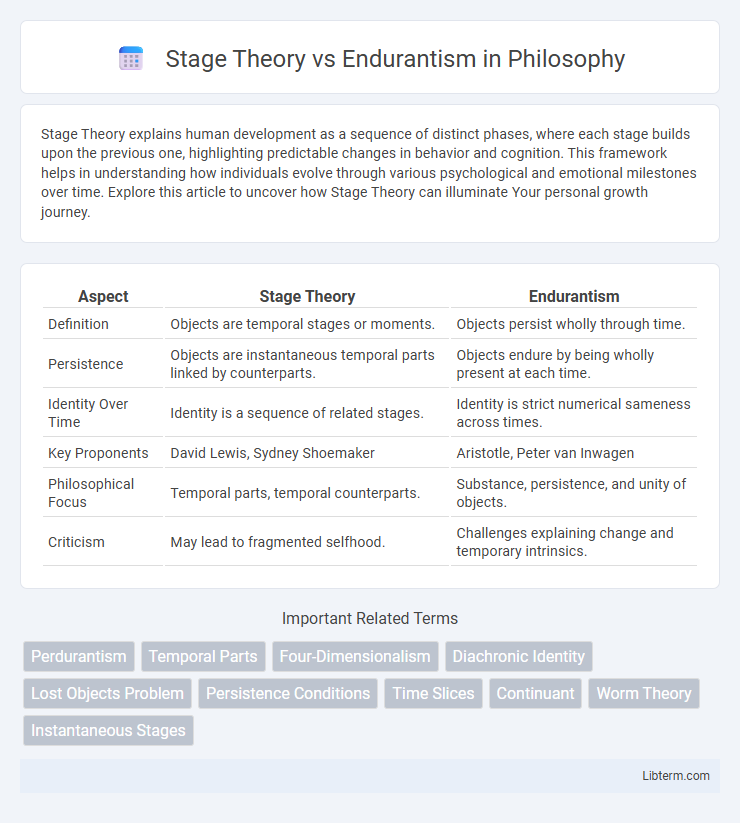Stage Theory explains human development as a sequence of distinct phases, where each stage builds upon the previous one, highlighting predictable changes in behavior and cognition. This framework helps in understanding how individuals evolve through various psychological and emotional milestones over time. Explore this article to uncover how Stage Theory can illuminate Your personal growth journey.
Table of Comparison
| Aspect | Stage Theory | Endurantism |
|---|---|---|
| Definition | Objects are temporal stages or moments. | Objects persist wholly through time. |
| Persistence | Objects are instantaneous temporal parts linked by counterparts. | Objects endure by being wholly present at each time. |
| Identity Over Time | Identity is a sequence of related stages. | Identity is strict numerical sameness across times. |
| Key Proponents | David Lewis, Sydney Shoemaker | Aristotle, Peter van Inwagen |
| Philosophical Focus | Temporal parts, temporal counterparts. | Substance, persistence, and unity of objects. |
| Criticism | May lead to fragmented selfhood. | Challenges explaining change and temporary intrinsics. |
Introduction to Stage Theory and Endurantism
Stage Theory posits that objects are temporal stages, existing only at a single moment in time, emphasizing temporal parts as distinct entities. Endurantism holds that objects are wholly present at every moment of their existence, persisting through time without being divisible into temporal parts. Both theories address the nature of persistence, with Stage Theory highlighting temporal division and Endurantism stressing continuous, complete presence.
Defining Stage Theory in Metaphysics
Stage Theory in metaphysics posits that individual entities are momentary stages or temporal parts rather than enduring wholes persisting through time. Each stage exists at a specific temporal location, and what we perceive as a persisting object is a series or collection of these temporal stages linked by relations such as temporal counterpart relations. This theory contrasts with Endurantism, which holds that objects are wholly present at every moment of their existence and persist identically through time.
Understanding Endurantism: Key Concepts
Endurantism posits that objects are wholly present at every moment of their existence, emphasizing persistence through time by enduring unchanged. Key concepts include the idea of three-dimensional objects maintaining their identity despite temporal parts or changes, contrasting with stage theory's division of entities into temporal slices. This perspective facilitates a unified understanding of object continuity and identity over time without fragmenting existence into discrete stages.
Historical Development of Both Theories
Stage Theory, rooted in early 20th-century analytic philosophy, evolved prominently through the works of philosophers like David Lewis, who emphasized temporal parts and transient stages of objects to explain persistence over time. Endurantism, with origins in Aristotelian metaphysics and revitalized in contemporary debates by philosophers such as Michael Loux, holds that objects are wholly present at each moment of their existence, rejecting the division of objects into temporal slices. The historical development of both theories reflects a deepening inquiry into the nature of identity and persistence, contrasting the four-dimensionalism of Stage Theory with the three-dimensionalism of Endurantism.
Main Differences Between Stage Theory and Endurantism
Stage Theory posits that objects are temporal stages or temporal parts existing at specific times, emphasizing a four-dimensional perspective where entities are extended through time. Endurantism maintains that objects are wholly present at every moment of their existence, supporting a three-dimensional view with objects persisting by enduring through time. The main difference lies in how persistence is understood: Stage Theory treats persistence as a series of successive temporal parts, while Endurantism sees objects as complete and unchanging wholes throughout time.
Persistence Through Time: Contrasting Views
Stage Theory asserts that objects are instantaneous temporal stages, meaning persistence through time is understood as a series of distinct, time-indexed stages. Endurantism, in contrast, holds that objects are wholly present at every moment of their existence, maintaining identity by enduring through time rather than by having temporal parts. This fundamental difference shapes debates on object identity and metaphysical persistence, with Stage Theory emphasizing temporal parts and Endurantism emphasizing continuous existence.
Philosophical Implications and Debates
Stage Theory posits that objects are temporal stages existing moment-by-moment, challenging traditional notions of persistence by emphasizing fleeting, time-bound entities. Endurantism argues that objects persist wholly through time, maintaining identity despite changes, which raises questions about how objects endure temporal variation while retaining their essence. The debate influences metaphysical discussions on identity, change, and the nature of time, shaping perspectives on how objects exist and endure across temporal intervals.
Applications in Contemporary Metaphysics
Stage Theory, positing that objects are temporal stages existing at specific times, offers valuable insights for analyzing persistence and identity over time in contemporary metaphysics by addressing problems of change and temporary intrinsics. Endurantism, asserting that objects are wholly present at each moment of their existence, provides a framework for understanding enduring objects in debates on identity and time, influencing discussions in philosophy of mind and metaphysics of time. Both theories apply to issues such as personal identity, temporal parts, and modal properties, shaping current metaphysical approaches to persistence and diachronic continuity.
Criticisms and Counterarguments
Stage Theory faces criticism for its fragmentation of persistence, as objects are seen as temporal stages rather than continuous entities, challenging intuitions about identity over time. Endurantism counters by emphasizing objects as wholly present at every moment, but struggles with explaining change and temporal parts coherently. Critics argue Endurantism's approach complicates accounting for object persistence during transformation, while supporters of Stage Theory maintain it better accommodates the reality of temporal variation.
Conclusion: Evaluating Stage Theory vs Endurantism
Stage Theory offers a fragmented but temporally precise model of persistence by treating objects as sequences of temporal parts, emphasizing change and identity over time. Endurantism, by contrast, maintains objects as wholly present at each moment, supporting intuitive notions of persistence and object continuity. Evaluating these theories depends on balancing metaphysical coherence with alignment to common-sense experience and scientific practice.
Stage Theory Infographic

 libterm.com
libterm.com